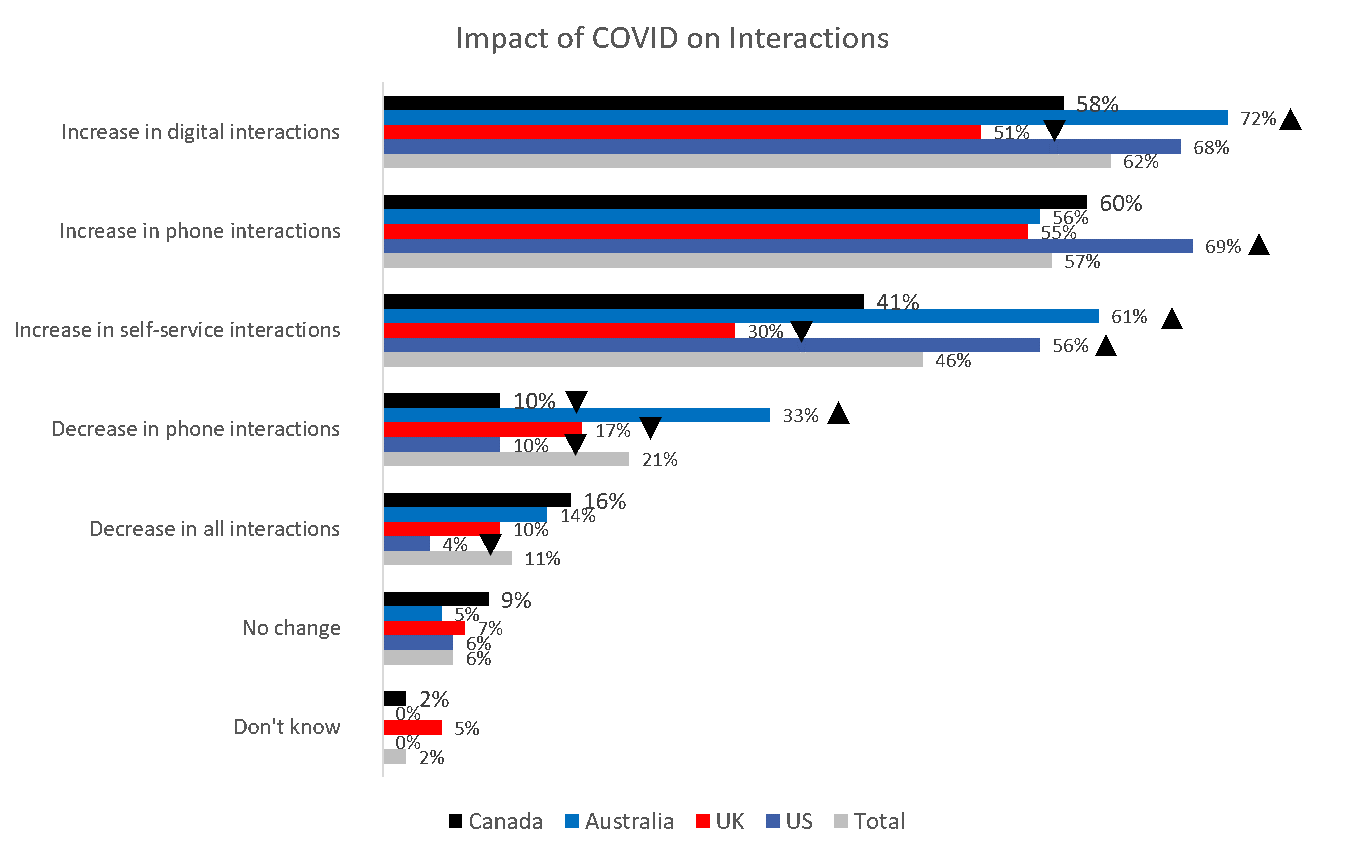Just about everybody is waiting for the elusive “return to normalcy.” But for many, that may not mean going back to an office, including contact center agents and supervisors – jobs traditionally considered “on site” positions.
The rise of COVID-19 has prompted many contact centers to embrace remote working amid stay-at-home orders and concern for employees’ health and safety. Indeed, the pandemic is, among many things, a massive experiment in telecommuting as the outbreak accelerates a trend towards a remote workforce, possibly for the long term. But that isn’t the only thing that’s on the mind of contact center leaders. Committed to learning from the current challenges and applying those lessons to emerge stronger from the crisis, leaders are rethinking many facets of their contact center operations besides agent location. This ranges from strategy and business continuity plans to channels and technology.
Permanent Work-From-Home Policies Gaining Steam
Given that businesses and regions will likely still be operating under some level of shelter in place for an extended period, a move back to centralized locations is low on leaders’ list of priorities. Particularly in a contact center environment, which are usually within close quarters, the rules for opening offices are especially challenging to implement.
It’s no surprise that a recent survey conducted by NICE, which focused on the impact of COVID-19 on contact centers, found 70 percent of world-wide contact centers expect they will continue to have agents work from home after the outbreak.
The flash survey of nearly 800 contact center decision makers around the globe assessed the impacts of the pandemic and examined how it may influence future cloud migration and work-from-home (WFH) plans. In addition to the aforementioned attitudes regarding long term remote work for contact centers, two other key themes emerged from the survey:
- Sharp increase in interactions due to COVID-19
- Companies of all sizes are fast-tracking their contact center’s move to the cloud
With remote working here to stay for the foreseeable future, how does a contact center not only cope, but also thrive and improve agent performance and customer satisfaction? First, let’s consider the changes contact centers have experienced since the pandemic began. Then, we will look at how the pandemic and the rapid transition to virtual workplaces that followed has exposed critical shortcomings in older technology and business continuity plans.
Increased Interactions
The study found that 92 percent of the contact center respondents experienced an increased volume of interactions across both traditional and digital channels. By contrast, only 11 percent of respondents reported a decrease in interaction volume.
By interaction category, 62 percent of respondents reported an increase in digital interactions, 57 percent reported an increase in phone calls and 46 percent saw an upturn in self-service. Respondents from business-to-consumer (B2C) contact centers, specifically, reported a greater increase in digital engagement and a decline in phone interactions.
In a recent No Jitter article from Sheila McGee-Smith, a leading communications industry analyst, she noted “the increase in digital volume is likely related to the often-lengthy hold times consumers encountered when calling into contact centers during the early days of shelter in place. Further, an April 14 Washington Post article, ‘Press 1 for frustration: Customers run into record phone waits as companies grapple with worker safety,’ summarizes the frustration felt by so many. As the article detailed, customers attempting to call into contact centers to defer mortgage or credit card payments, collect unemployment, cancel airline flights, or locate missing shopping orders were stymied by the long hold times. While moving an interaction to chat, SMS, social media, or other digital channel may not have gotten you a response any more quickly, it did free you up until someone responded.”
To continue serving customers in this dynamic environment, call center software must have two very critical capabilities: elastic scalability and support for rapid changes to contact flows, interactive voice response (IVR) dialogs, and other operational processes. All of this is available in the cloud, and if they haven’t already, many contact centers are moving quickly to embrace it.
Moving to the Cloud
The survey showed that 66 percent of respondents whose companies are not using the cloud today are planning to accelerate their move to the cloud as a result of the pandemic.
Upon further analysis, respondents who already have their technology on the cloud are more likely to expect agents to keep working at home. In addition, B2C organizations are most likely to believe agents will continue working from home.
McGee-Smith proposed, “while having a cloud contact center platform simplified the WFH transition, many companies still supported by premises-based contact center solutions were also able to support a remote agent workforce using their existing technology. Rarely, however, do companies working on legacy premises systems think that what they did is a long-term solution. Agents had to download, install, and often troubleshoot the setup. They also often had to learn a new application interface. The inherent burden on the agents, in turn, put a strain on IT staff.
“Anecdotal evidence suggests that companies on premises systems will look to move contact centers to cloud-based software as a result of the issues faced when shelter-in-place orders were imposed.”
Indeed, cloud technologies can make the transition to the WFH model seamless and ensure that businesses thrive in the post-COVID-19 period.
Technology Investments Matter
After making immediate decisions about staffing and serving customers effectively through the crisis, contact center executives are in need of ways to fundamentally improve operations and customer service for the long term.
Many contact centers had resisted WFM arrangements in the past and, as a result, were unprepared when the crisis hit. Faced with no other option, representatives were sent home, often without the right equipment. While many organizations had upgrades, such as cloud telephony, on their roadmap, most are now fast-tracked to meet demand for virtual functionality.
With the topics of operational agility and business continuity being top of mind for business leaders, many are keenly aware of the importance of implementing digital solutions to achieve organizational goals and providing continuing customer support during market disruptions.
In his series of “Analyst Perspectives,” Mark Smith of Ventana Research concluded that digital innovation is not only key to success, but to survival. He noted “The first step in such planning is setting priorities with respect to maintaining processes or services and then, based on this ranking, allocating the technology investments necessary to sustain operations more effectively and potentially in a complete virtual manner.”
Does your organization have the right technology to continuously assess its ability to operate seamlessly and effectively? Smith explained, “effective business continuity planning must be periodically tested under realistic conditions and, where necessary, adjusted to ensure it is ready when the situation occurs. Organizations need digital innovation over simple digital transformation and should seek opportunities that will help them not only meet requirements for business continuity but take action in a more meaningful and rapid manner.”
Technology Solutions: On Premises vs. Cloud
Technology can severely limit business continuity plans if it lacks functionality and flexibility. In an on-premises environment, contact centers must achieve redundancy by deploying a duplicate hardware system on site. This is expensive to purchase and maintain, especially when it includes equipment that hopefully never gets used. However, even after a considerable investment, there is still no guarantee that the duplicate system is available to agents in the event of an emergency depending on the severity and footprint of the event. Further, the costs increase if the contact center wants geographic redundancy. On-premises solutions are also limited in flexibility and on-demand scalability, both of which are necessary to solve business continuity in many circumstances.
The tools available within the cloud solution for an at-home workforce should be the same as what was available to agents in the office, including compliance and quality management, performance management, analytics, and automation. Cloud solutions allow agents, supervisors, and administrators to access tools from anywhere with only an Ethernet connection and a computer, making it the winning choice for a resilient contact center platform. Most cloud contact center solutions can be deployed as a primary solution or as a supplemental or backup to an existing on-premises implementation. 800 numbers and DIDs can be automatically re-directed in the event of an outage, connecting customers to the same experienced agents – business as usual.
Business Continuity Best Practices
In a separate “Analyst Perspective,” Smith observed “operating under duress during a crisis such as a global pandemic and achieving business continuity is a challenge for any organization’s skillset, particularly if digital transformation investments did not make it to business areas that needed it — too often the contact center.”
He asserted that by 2022, after a decade of concerted efforts in digital transformation, one-half of organizations will not have established business continuity as an investment priority and will not be prepared to operate in a future pandemic or crisis, which will lead to increased operational risks.
Disaster recovery and business continuity plans are only successful if the contact center routing and call handling technology is available after the emergency hits and the organization is ready and prepared to pivot as necessary. Different disasters may need a different response or plan. NICE’s “Disaster Recovery and Business Continuity” white paper examines proactive strategies to minimize the impact from disasters and emergencies.
Consider some common best practices from companies who have successful strategies in place:
- If operating a contact center as part of your business, partner with a cloud contact center provider to design and review your BC/DR plan. They likely have redundancy and continuity built into their platform to keep your business going.
- Assign dedicated disaster recovery resource – preferably a team instead of just one person. This team should meet often and maintain or update the DR plan in response to changing business conditions.
- Train agents and supervisors on disaster recovery processes and systems as part of the onboarding process and provide frequent (quarterly) refreshers. The more knowledge workers that understand how the system responds in the wake of a disaster, the better.
- Provide written instructions of disaster recovery procedures. Documentation is often overlooked, but there should be a central resource that anyone can refer to. A best practice is to maintain both physical and digital copies of these procedures – depending on the type of disaster, one could be easily lost or destroyed.
- Get monthly system health checks customized to your solution to ensure everything works as specified.
- Fully test your internal disaster recovery plan 1 – 2 times per year (evacuation, meeting places, communication, etc.). Undertake a quarterly readiness test for all employees if possible.
- Work with carriers to establish lead times of forwarding or re-pointing phone numbers.
To assist with your business continuity planning, NICE provides a wealth of resources, including a remote agent checklist.
An Enduring Impact
Covid-19, and all the disruption it has caused, will have a lasting influence on the future of work and will not soon be forgotten by organizational leaders, shareholders, or other stakeholders. Those who were not ready this time will learn what worked and what didn’t work and will be compelled to close the gaps so they are better prepared in the future.
Since the “new normal” appears to be trending towards standardized WFM practices and contact center modernization, determining the path forward for 2020 and beyond requires an effective strategy and an understanding of how to best sustain your contact center. Make sure you are using technology for agent management that can provide an effective customer experience, effectively handle increased interactions, and foster sustainable long-term relationships.
NICE CXone provides a future-proof solution, helping companies act smarter, respond faster and be the first in customer experience. As the leading cloud platform for contact centers, NICE CXone has a global, geographically redundant cloud infrastructure with built-in elasticity to dynamically scale up or down based on demand, empowering organizations of all sizes to provide exceptional customer experiences with the most advanced capabilities available today, in a true unified cloud platform. To learn more about CXone, visit www.niceincontact.com.







